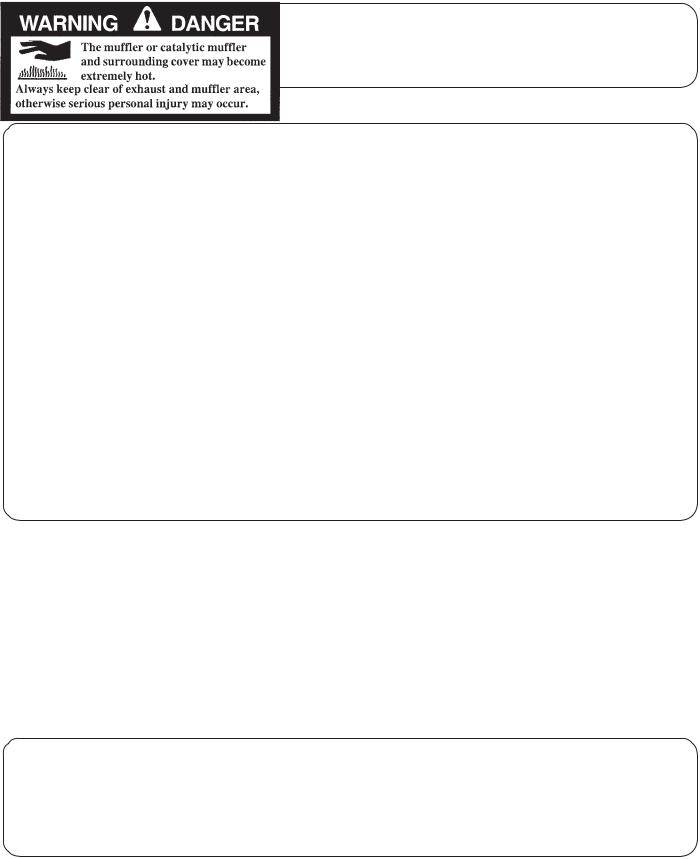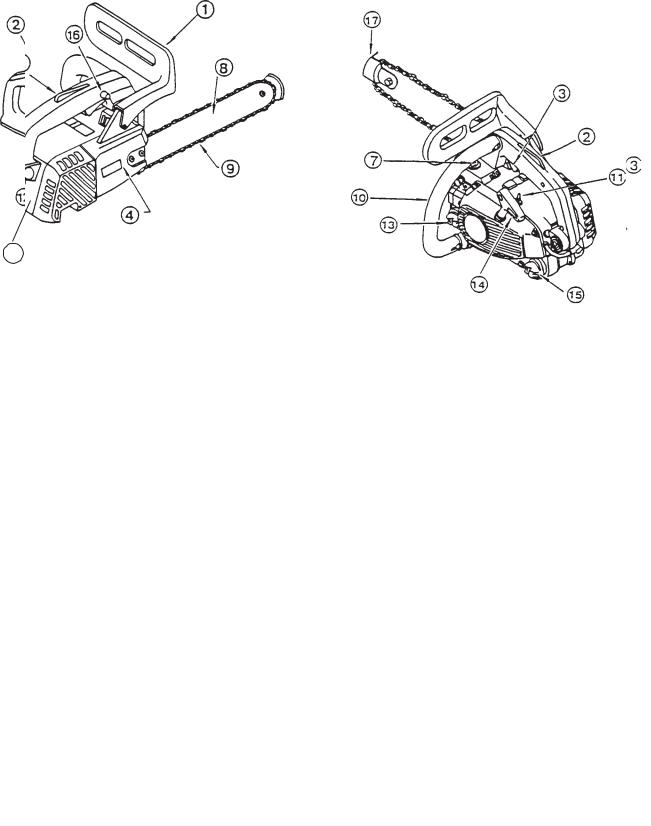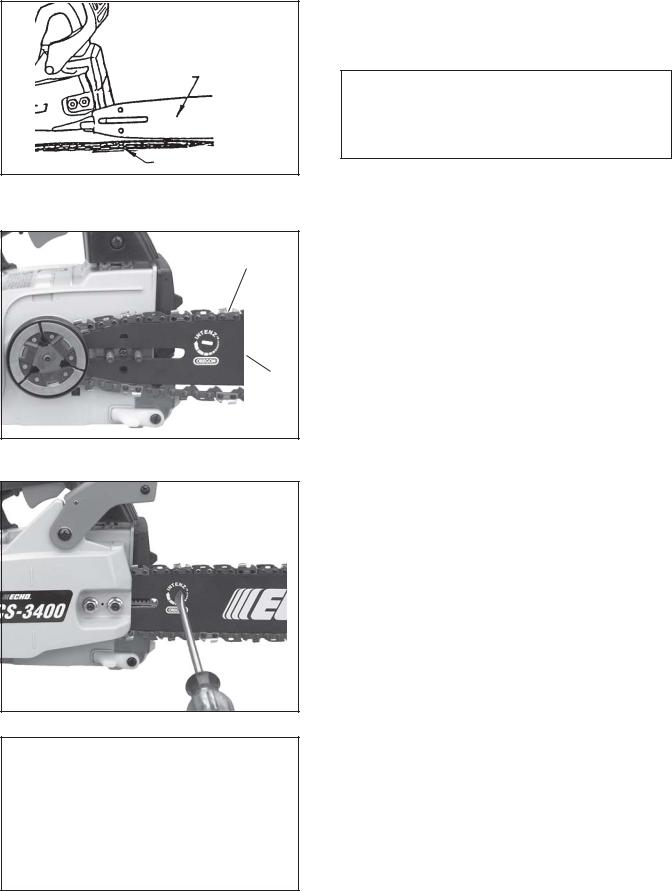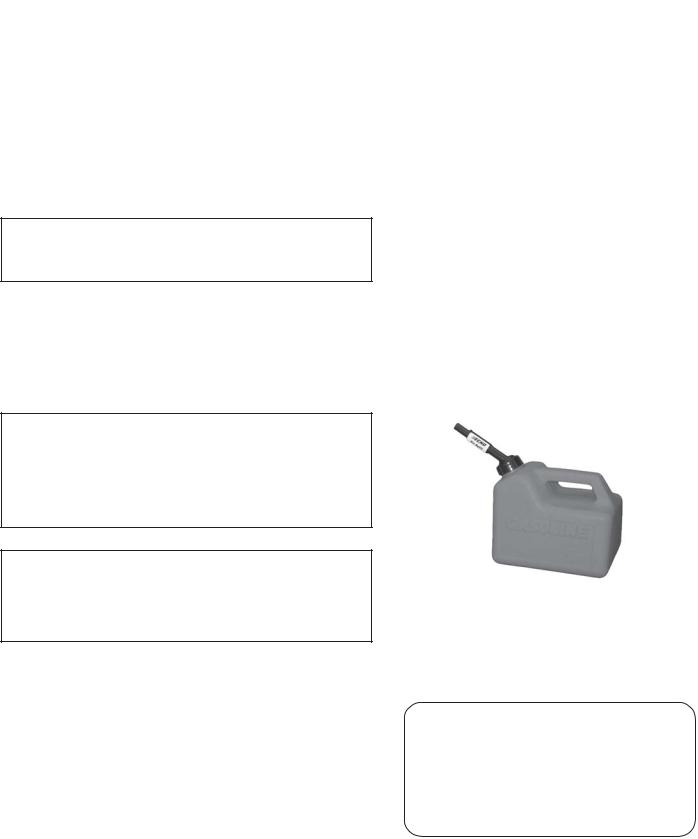Echo CS-3450 TYPE 1E, CS-3000 TYPE 1E Manual

Chain Saw
InstructionManual
MODELS : |
CS-3000 TYPE 1E |
|
Serial Number 665926 - 999999 |
|
CS-3400 TYPE 1E |
|
Serial Number 593342 - 999999 |
|
CS-3450 TYPE 1E |
|
Serial Number 617762 - 999999 |
WARNING  DANGER
DANGER
Readrulesforsafeoperationandinstructionscarefully.ECHOprovidesanInstruction Manual and a Safety Manual. Both must be read and understood for proper and safe operation.
X7503200008 |
X750001412 |
|
06/02 |
||
|
RULES FOR SAFE OPERATION
A. Kickback Safety Precaution for Chain Saw Users
WARNING!
KICKBACK may occur when the nose or tip of the guide bar touches an object, or when the wood closes in and pinches the saw chain in the cut.
Tip contact in some cases may cause a lightning fast reverse REACTION, Kicking the guide bar up and back towards the operator. Pinching the saw chain along the top of the guide bar may push the guide bar rapidly back towards the operator. Either of these reactions may cause you to lose control of the saw which could result in serious personal injury.
Do not rely exclusively upon the safety devices built into your saw.As a chain saw user, you should take several steps to keep your cutting jobs free from accident or injury.
1.With a basic understanding of kickback, you can reduce or eliminate the element of surprise.
Sudden surprise contributes to accidents.
2. Keep a good firm grip on the saw with both hands, the right hand on the rear handle, and the left hand on the front handle, when the engine is running. Use a firm grip with thumbs and fingers encircling the chain saw handles. A firm grip will help you reduce kickback and maintain control of the saw. Don’t’ let go.
3.Make sure that the area in which you are cutting is free from obstructions. Do not let the nose of the guide bar contact a log, branch, or any other obstruction which could be hit while you are operating the saw.
4.Cut at high engine speeds.
5.Do not overreach or cut above shoulder height.
6.Follow manufacturer’s sharpening and maintenance instructions for the saw chain.
7.Only use replacement bars and chains specified by the manufacturer or the equivalent.
B.Other Safety Precautions
1.Do not operate a chain saw with one hand! Se- 4. Use caution when handling fuel. Move the chain
rious injury to the operator, helpers, bystanders, or any combination of these persons may result from one-handed operation. A chain saw is intended for two-handed use.
2.Do not operate a chain saw when you are fatigued.
3.Use safety footwear; snug-fitting clothing; protective gloves; and eye, hearing and head protection devices.
saw at least 10 feet (3 m) from the fueling point before starting the engine.
5.Do not allow other persons to be near the chain saw when starting or cutting with the chain saw.
Keep bystanders and animals out of the work area.
6.Do not start cutting until you have a clear work area, secure footing, and a planned retreat path from the falling tree.
2
7.Keep all parts of your body away from the saw chain when the engine is running.
8.Before you start the engine, make sure that the saw chain is not contacting anything.
9.Carry the chain saw with the engine stopped, the guide bar and saw chain to the rear, and the muffler away from your body.
10.Do not operate a chain saw that is damaged, improperly adjusted, or not completely and securely assembled. Be sure that the saw chain stops moving when the throttle control trigger is released.
11.Shut off the engine before setting the chain saw down.
12.Use extreme caution when cutting small size brush and saplings because slender material may catch the saw chain and be whipped toward you or pull you off balance.
13.When cutting a limb that is under tension, be alert for spring back so that you will not be struck when the tension in the wood fibers is released.
14.Keep the handles dry, clean, and free of oil or fuel mixture.
15.Operate the chain saw only in well-ventilated areas.
16.Do not operate a chain saw in a tree unless you have been specifically trained to do so.
17.All chain saw service, other than the items listed in the Instruction Manual maintenance instructions, should be performed by competent chain saw service personnel. (For example, if improper tools are used to remove the flywheel or if an improper tool is used to hold the flywheel in order to remove the clutch, structural damage to the flywheel could occur and could subsequently cause the flywheel to burst.)
18.When transporting your chain saw, use the appropriate guide bar scabbard.
19.Spark arrester mufflers approved to SAE Standard J335b are Standard on ECHO Chain saws to reduce the possibility of forest fires. Do not operate the chain saw with a loose or defective muffler. Do not remove the spark arrester screen.
|
CONTENTS |
|
Page |
Rules for Safe Operation .................................................................................................. |
2 |
Technical Data ................................................................................................................. |
4 |
Nomenclature of Parts ...................................................................................................... |
5 |
Preparation for Use .......................................................................................................... |
6 |
Fuel and Lubricant............................................................................................................ |
7 |
Operation ......................................................................................................................... |
8 |
Cutting Instructions ......................................................................................................... |
10 |
Maintenance and Care ................................................................................................... |
14 |
Chain and Guide Bar Combinations ............................................................................... |
17 |
Setting the Saw Chain .................................................................................................... |
17 |
Troubleshooting.............................................................................................................. |
19 |
Storage .......................................................................................................................... |
20 |
Correct Use of Chain Brake ........................................................................................... |
21 |
Servicing Information ...................................................................................................... |
24 |
3
TECHNICAL DATA
Model |
|
|
CS-3000 TYPE 1-E |
CS-3400 TYPE 1-E |
CS-3450 TYPE 1-E |
|
|
|
|
|
|
Dimension |
L x W x H |
mm |
260 x 230 x 220 |
380 x 230 x 245 |
|
|
|
|
|
|
|
|
|
inch |
10.2 x 9.1 x 8.7 |
15.0 x 9.1 x 9.6 |
|
|
|
|
|
|
|
Weight |
Power head, dry |
kg |
3.2 (7.1 lb) |
3.3 (7.3 lb) |
3.4 (7.5 lb) |
|
|
|
|
|
|
|
|
|
Without chain and guide bar |
||
|
|
|
|
|
|
Engine |
Type |
cc |
Air-cooled, two-stroke, single cylinder |
|
|
|
|
|
|
|
|
|
Displacement |
|
30.1 (1.83 cu.in.) |
33.4 (2.03 cu.in.) |
|
|
|
|
|
|
|
|
Carburetor |
|
Diaphragm type |
|
|
|
Magneto |
|
Flywheel magneto : CDI system |
|
|
|
Spark Plug |
|
NGK BPM-7A |
|
|
|
Starter |
|
Recoil starter |
|
|
|
Power transmission |
|
Automatic centrifugal clutch |
|
|
|
|
|
|
|
|
Fuel |
Mixture ratio |
|
50:1 ratio with ECHO brand two-stroke oil. |
|
|
|
|
|
89 octane unleaded. Do not use fuel containing methyl alcohol, |
||
|
|
|
more than 10% ethyl alcohol or 15% MTBE. |
|
|
|
|
|
|
|
|
|
Tank Capacity |
liter |
0.25 (8.6 fl oz U.S.) |
|
|
|
|
|
|
|
|
Oil |
Bar and chain |
|
ECHO bar and chain oil (or motor oil) |
|
|
|
|
|
|
|
|
|
Tank Capacity |
liter |
0.15 (5 fl. oz. U.S.) |
|
|
|
|
|
|
|
|
Guide bar |
|
|
12 in. Standard |
14 in. Standard |
16 in. Standard |
|
|
|
|
|
|
Saw chain |
|
|
14, 16 in. Optional |
12, 16 in. Optional |
12, 14 in. Optional |
|
|
|
|
|
|
|
Lubrication |
|
Adjustable automatic oil pump |
|
|
|
|
|
|
|
|
Standard |
|
|
Top Handle |
Conventional handle |
|
features |
|
|
|
Rear hand guard |
|
|
|
|
|
|
|
|
|
|
Front hand guard, |
|
|
|
|
|
Anti-vibration device, |
|
|
|
|
|
Throttle control lockout, Chain brake, |
|
|
|
|
|
Chain catcher, Spark arrestor muffler |
|
|
|
|
|
|
|
|
* Technical data subject to change without notice.
4

NOMENCLATURE OF PARTS
CS-3000, CS-3400
18
1. |
Hand guard |
6. |
Air cleaner cover |
12. |
Rear hand guard |
|
|
(Chain brake actuating lever) |
7. |
Purge bulb |
13. |
Fuel tank cap |
|
|
|
|||||
2. |
Throttle control lockout |
8. |
Guide bar |
14. |
Pull starter |
|
|
|
|||||
3. |
Throttle control trigger |
9. |
Saw chain |
15. |
Oil tank cap |
|
4. |
Sprocket guard |
|||||
10. |
Front handle |
16. |
Throttle control latch |
|||
5. |
Chain catcher |
|||||
11. |
On / Off switch |
17. |
Tip guard |
|||
|
|
|||||
|
|
|
|
18. |
Lanyard ring |
CS-3450
5

PREPARATION FOR USE
B
A
UP
C
The machine may be delivered with guide bar (A) and saw chain (B) separated. Install guide bar and saw chain as follows:
WARNING  DANGER
DANGER
Saw Chain is sharp! Always wear gloves when handling assembly, otherwise serious personal injury may result.
GUIDE BAR AND SAW CHAIN
•Follow the instructions enclosed with tip guard to install guard to guide bar.
•Remove two guide bar nuts and remove sprocket guard (C).
•Mount guide bar (A) on studs, and slide toward sprocket to make saw chain installation easier.
•Install saw chain (B) as shown, with cutters facing forward.
NOTE
Chain brake must be in fully released position to install sprocket guard to saw.
•Install sprocket guard (C), and tighten guide bar nuts finger tight.
•Adjust saw chain tension, as instructed in “Adjustment, Chain Tension.”
ADJUSTMENT, CHAIN TENSION
•Loosen two guide bar nuts.
•Turn the adjuster slot clockwise until the chain touches the bottom of the bar.
•Hold the bar nose up and tighten the chain until there is no clearance between the bar and chain.
•Tighten both guide bar nuts with bar nose held up, to eliminate clearance.
•Pull the saw chain around the guide bar by hand. Loosen the adjustment, if you feel tight spots.
•Start the engine and run at low speed. Stop and readjust, if necessary.
CAUTION
1.All adjustments should be made cold.
2.Always wear gloves when working on chain.
3.Do not operate with a loose chain.
6

FUEL AND LUBRICANT
FUEL STATEMENT
Gasoline - Use 89 Octane [R+M/2] (mid grade or higher) gasoline known to be good quality. Gasoline may contain up to 15% MTBE (methyl tertiary-butyl ether). Gasohol containing methyl (wood) alcohol is NOT approved.
Two Stroke Oil - A two-stroke engine oil meeting ISO-L-EGD (ISO/CD 13738) and J.A.S.O. FC Standards, must be used. Echo brand Premium 50:1 oil meets these standards. Engine problems due to inadequate lubrication caused by failure to use an ISO-L-EGD and J.A.S.O. FC certified oil, such as Echo Premium 50:1 Two-stroke Oil, will void the two-stroke engine warranty. (Emission related parts only are covered for two years, regardless of two-stroke oil used, per the statement listed in the EPA Phase I Emission Defect Warranty Explanation.)
IMPORTANT
Echo Premium 2-Stroke Oil may be mixed at 50:1 ratio for application in all Echo engines sold in the past regardless of ratio specified in those manuals.
MixingInstructions
1.Fill an approved fuel container with half of the required amount of gasoline.
2.Add 2-stroke oil to gasoline.
3.Close container and shake to mix oil with gasoline.
4.Add remaining gasoline and remix.
5.Install fuel container cap and wipe any spilled fuel from container and surrounding area.
IMPORTANT
Stored fuel ages. Do not mix more fuel than you expect to use in thirty (30) days, ninety (90) days when a fuel stabilizer is added.
Stored two-stroke fuel may separate. ALWAYS shake fuel container thoroughly before each use.
IMPORTANT
Spilled fuel is a leading cause of hydrocarbon emissions. Some states may require the use of automatic fuel shutoff containers to reduce fuel spillage. Contact your ECHO dealer for ordering information.
Oil
50
Gasoline
Fuel Mix Chart
50:1
|
(U.S.) |
|
(METRIC) |
|
||
|
|
|
|
|
|
|
|
GAS |
|
OIL |
GAS |
OIL |
|
|
|
|
|
|
|
|
|
Gal. |
|
Fl. oz. |
Liter |
cc. |
|
|
|
|
|
|
|
|
|
1 |
|
2.6 |
4 |
80 |
|
|
2 |
|
5.1 |
8 |
160 |
|
|
5 |
|
12.8 |
20 |
400 |
|
|
|
|
|
|
|
|
|
|
|
|
|
|
|
|
|
|
|
|
|
|
CHAIN LUBRICANT
Proper lubrication of the chain while in operation reduces friction between the chain and the guide bar to a minimum and assures a longer service life.
•Use high quality ECHO bar and chain oil for this purpose.
•Do not use used or reclaimed oil to avoid various oiler problems.
•Use bar and chain oil of the following grades: SAE NO. 30 ..... in summer
SAE NO. 10 ..... in winter or when cutting resinous trees.
•When refueling, also refill chain oil.
TANK INDICATION
FUEL TANK |
OIL TANK |
7

OPERATION
WHEN THE ENGINE IS COLD
•Move chain brake lever fully forward to engage chain brake before starting.
•Fill the fuel tank with fuel.
•Fill the chain oil tank with lubricant.
•Turn switch (A) to “RUN” position.
•Pull choke (B) all the way out (close position).
•Push purge bulb (C) 10 times.
•Pull starter handle several times until first firing sound. (Hold machine with your knee or foot.)
•Push choke (B) all the way in. (open position)
•Pull starter handle again.
A
CS-3450 A
CS-3000
CS-3400
WHEN THE ENGINE IS HARD TO START
•Press throttle control lockout down while holding throttle trigger, and push in throttle control latch.
•Pull starter handle.
•When engine starts, immediately squeeze throttle trigger to release the latch.
CAUTION
Clutch engages and chain will rotate when engine is started with throttle control latch engaged.
After engine starts, release throttle trigger to idle engine. Never use the throttle control latch for cutting.
Use only when starting the engine.
Make sure bar and chain are not touching anything when starting the saw.
Do not pull starter rope out to the maximum possible position.
Do not allow recoil handle to snap back against the casing.
C
Securely hold the saw.
8
